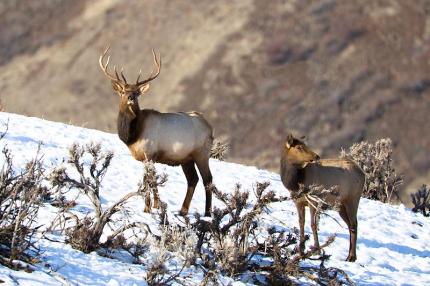
Per a rule approved by the WDFW director, effective May 17, 2025 it is illegal to feed deer, elk, and moose in Washington, as feeding draws animals together where they can spread disease. It is also illegal to place feed for other wildlife if it causes deer, elk, or moose to congregate. WDFW is evaluating its own wildlife feeding practices in areas where elk are fed to reduce human-wildlife conflict in agricultural areas.
When the temperature drops and snow falls, or when does arrive with their new fawns in the spring, many people want to feed deer and other wildlife in an effort to "help" the animals. While the Washington Department of Fish and Wildlife (WDFW) conducts winter feeding under certain conditions, we generally discourage citizens from feeding deer, elk and other wildlife species any time of year because of the potential for harm.
The greatest drawback to feeding deer or elk is the potential harm to their health.
The digestive systems of free-ranging elk and deer are not able to use many types of artificial feed efficiently. Fruit and grains are not a normal part of a deer's diet and can be extremely difficult for deer to digest. Their rumens need time to adjust to a high carbohydrate diet, and they can die from rumen acidosis when experiencing a rapid transition from normal forage to fruit or grain.
Corn and apples are especially hard for them to digest because the gut microbes needed to break them down are different than those that break down their more fibrous natural foods during winter. This mismatch in gut microbes can result in animals that starve because they are unable to absorb the nutrients they need. In addition, fruit and grains don't have the right amounts and types of vitamins, minerals, and especially fiber that deer and elk need to stay healthy. Feeding these alternative foods is similar to feeding your children nothing but candy bars.
Even with a specially formulated pelletized deer feed (as is used by WDFW in special circumstances), the process to successfully feed deer is complex. Any shift in foods must happen gradually over weeks to allow gut microbes to adjust. While loss of body fat over the winter is a natural part of the cycle, the additional energy used for diet adjustment can speed up the process of weight loss. Once a diet shift has occurred, feeding must be continued until they can adjust back to natural foods in the spring.
The final cost of feeding can be substantial. If an average deer eats three to four pounds of feed per day over four months, one deer could consume almost 500 pounds of feed.
Concentrating deer and elk at a feeder can create problems by making the animals more vulnerable to disease, predation and poaching. If feeding areas draw animals across well-traveled roads, they are more likely to present a safety hazard and be hit by cars. Deer and elk drawn to artificial feed also can damage nearby agricultural areas, trees, or landscaping, especially if the artificial feed supply is not maintained.
Winter wildlife feeding
Deer, elk and other animals have developed adaptations that allow them to survive harsh winter conditions without human intervention. These adaptations include building fat and muscle during the summer growing season, migrating long distances, dispersing across the landscape to reduce concentrations, lowering metabolic rates during the winter season, and restricting movements during severe winter conditions to conserve energy.
The best way to help wild animals survive a severe winter is to promote year-round quality habitat. If animals go into the winter in good condition, most are able to survive persistent deep snow, ice and cold temperatures. Even in well-functioning natural ecosystems, however, some animals succumb during winter months. The winter season helps keep wildlife populations more in balance with available habitat.
Another way to help wild animals in winter is to avoid disturbing them. Animals must conserve their energy to survive winter conditions, and human disturbance causes them to move about. Keep dogs confined, and slow down when traveling in motor vehicles through deer and elk habitat.
Wildlife biologists recognize that it is not effective nor beneficial to attempt winter feeding throughout the state, and we don't have the resources to do so. However, in special circumstances we provide carefully managed supplemental feeding programs for certain wildlife populations.
For example, at WDFW's Oak Creek, L.T. Murray and Wenas wildlife areas in south-central Washington, elk and bighorn sheep are fed throughout the winter. In concert with extensive fencing, the feeding program helps keep elk and bighorn sheep off adjacent private property where they may cause damage or contract diseases from domestic animals. A side benefit of this traditional feeding program is a public wildlife-viewing opportunity.
In other instances, wildlife biologists may feed wild animals to draw them in for capture to monitor their health or for relocation projects.
In a small number of cases, WDFW may provide winter feed under emergency conditions such as:
- When winter range has been lost to wildfires, drought or other natural disasters .
- Circumstances where persistent severe conditions concentrate animals or draw them into private orchards or other cropland where they haven't posed problems before.
- Severe weather conditions including but not limited to abnormally cold temperatures, extreme wind chill, well above average snow depth, icing or crusting of snow for prolonged periods of time.
- Restricted access to natural forage.
- Physical condition of the wildlife in question.
All of these factors are considered before WDFW initiates emergency feeding operations.
Additional resources
- WDFW Brochure: Feeding urban and suburban deer... is it harmful? (PDF)
- WAFWA Fact Sheet: Understanding mule deer and winter feeding